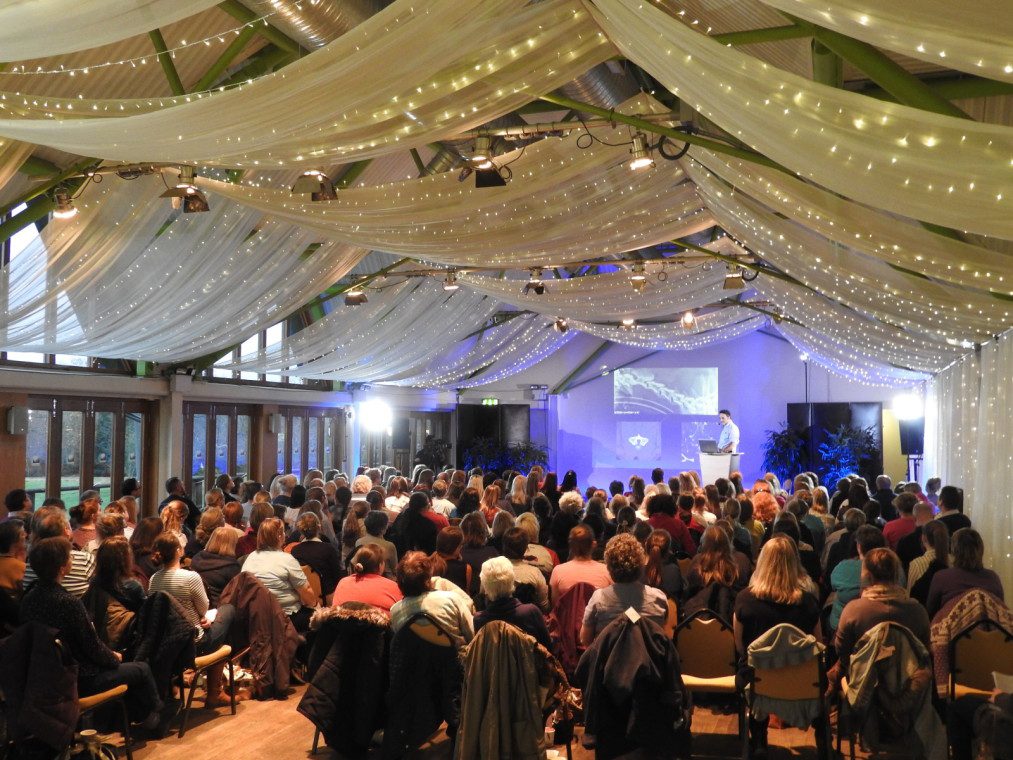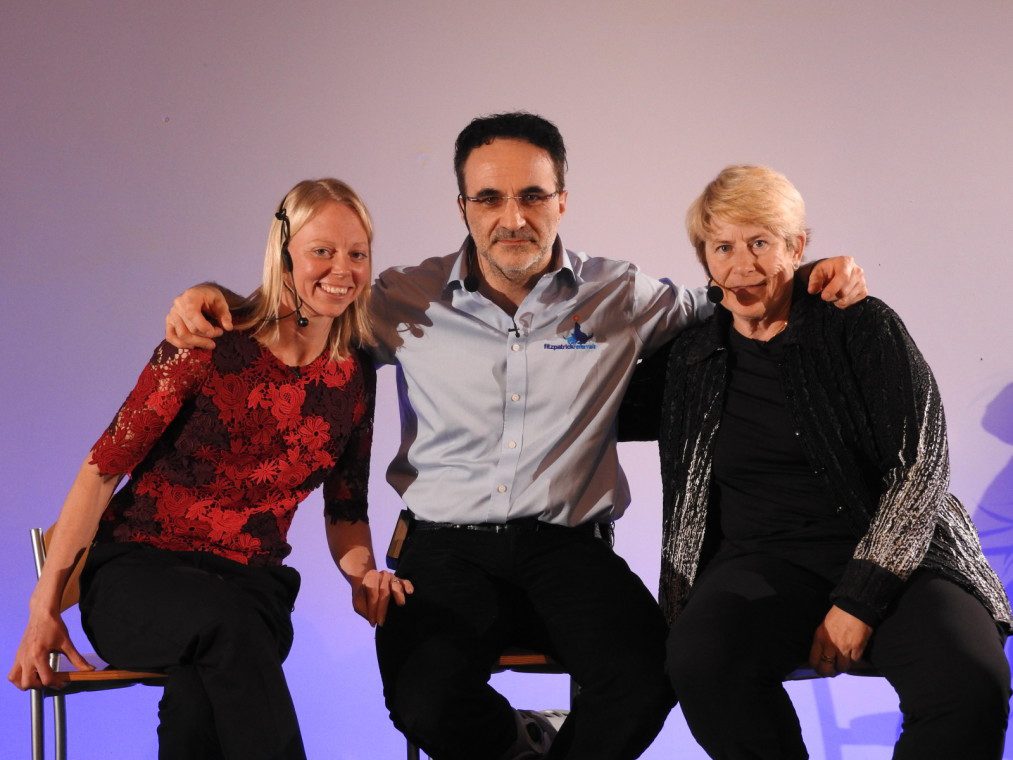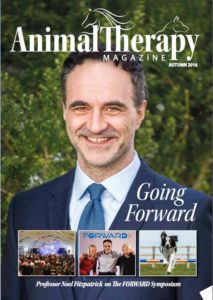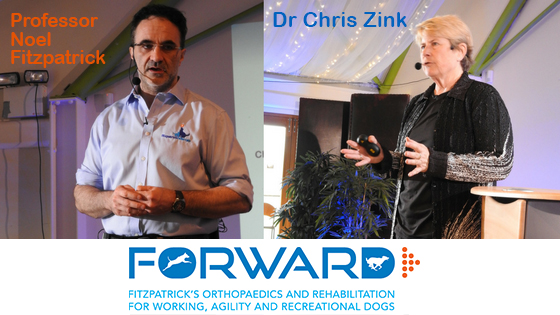Ahead of the FORWARD Symposium in 2017 Animal Therapy Magazine spoke to Noel Fitzpatrick and Chris Zink about what we can expect to see next year!
Tell us more about FORWARD? What motivated you to create the symposium?
Noel Fitzpatrick: FORWARD stands for Fitzpatrick’s Orthopaedics and Rehabilitation for Working, Agility and Recreational Dogs. It is an exciting new initiative to guide dog owners on the best techniques to manage, treat and prevent injuries in athletic dogs. Dogs are athletes, and they require a regime and careful monitoring just like us to maintain fitness and performance. However, despite best intentions, accidents and injuries can still happen, so we all need to manage diagnosis, treatment and rehabilitation as efficiently and effectively as possible.
The inaugural FORWARD Symposium held in January 2016 explored the most common musculoskeletal conditions that affect working and performance dogs, and most importantly how to bring them back to competition level after an injury. Many people believe an injury can cause the end of your dog’s working or performance career, but this is not necessarily true.
Following this year’s sell-out event and a fantastic response from those who attended, we are pleased to be holding a second symposium in February 2017 with a new line-up of speakers and fresh topics. For instance, we are welcoming a police dog handler from the Metropolitan Police which I am very excited about. I am also delighted that Dr Chris Zink is returning to talk about everything you need to know on achieving and maintaining your dog at the very peak of fitness.
It was wonderful last year to see so many like-minded people together, learning from not only the experts speaking, but also from one another – the mutual respect, collaboration and broader understanding gained was terrific to see. It is the most exciting event of its kind in the UK and it promises to be a really great day!

The 2016 symposium talks about common conditions in agility, working and performance dogs. What would you say is the most common injury or injuries you come across?
Noel Fitzpatrick: Most of the common injuries I see are musculotendinous tissue. Second to this are spinal problems which can predicate imbalance, especially if core stability is poor and thirdly, joint problems with acute traumatic injuries to bone being less common.
Do you believe there are any underlying factors (such as conformation) that make these injuries more likely, or is it just the wear and tear of hard work, or just bad luck? Do you have any advice to owners on preventing such injuries?
Noel Fitzpatrick: There are undoubtedly conformational factors and potentially genetically predisposed problems which can make injuries more likely in my opinion. Obviously the wear and tear of hard work contributes as well. I think it is also very important to recognise a situation which may predicate injury possibility such as lumbosacral disease in working and athletic dogs which in my opinion, is greatly underdiagnosed and may contribute to issues such as iliopsoas and epaxial muscle discomfort as well as pelvic limb imbalance.
I think it is very important to be aware of the more advanced modalities for minimally invasive intervention. This ranges from advances in platelet-rich plasma and stem cell technology through to minimally invasive arthroscopic surgeries. The landscape for potential intervention regarding injury in agility, working and performance dogs has completely changed and it behoves all of us to be aware of the options to return dogs to competition and to maintain quality of life.
Ultimately I think that most dogs, just like humans, have some inbuilt genetic advantages or disadvantages but ultimately, diet, training and conditioning are the key elements to gain maximum performance for any dog.
I think the key issue is appropriate conditioning and training and preparation for key events in a structured, sensible fashion. Again this is similar to a human athlete preparing for competition. It can be hard to maintain peak performance over a prolonged period so events should be carefully sequenced around the training regime. I think it is also vital to be aware of the most advanced diagnostic techniques available; whether that is just good clinical judgment or modalities such as ultrasound and MRI.
Human athletes generally have a very specific preparation programme including warm up and cool down stretches, yet we don’t often see the same in our canine athletes. If you could give an owner 5 key exercises to do pre and post exercise, what would they be?
Chris Zink: This is a typical warm-up routine that I recommend. For a Cool-down, the exercises can be done in the order 3, 1, 4.
| Exercise Progression | Description |
Frequency/Duration/ Intensity |
| 1. Walking on leash |
· Start with this – be sure your dog is in a walking gait · Other easy early warm up activities include: o Weaving through legs o Spinning – small and larger circles |
2 to 3 minutes |
| 2. Trotting |
· Have your dog trot at a moderate speed on leash at your side · You can also have the dog do some retrieving during this period |
3-5 minutes |
| 3. Tugging and Other Tight Moves |
· Do some tugging with a toy that is on a stretchy line (like a bungie) so that it doesn’t put too much stress on the dog’s spine (or your arm!) · Backing up · Waving – high 5’s (HIGH) |
1 to 2 minutes |
| 4. Stretch |
· Spinal Extension: Have your dog do a play bow and hold it for 10 seconds. This extends the spine · Spinal Flexion: Have your dog stand and put your hands under the chest just behind the elbows. Put the food on the ground between the front legs, or even behind the front legs while you push up on the chest with your other hand. This flexes the spine. · Lateral Spine Stretches: o While your dog is nibbling on a snack, move it along the side of your dog’s neck, then along the spine towards the pelvis, stopping for about 3 seconds at the pelvis. o Then move the food down along the side of the dog’s leg and pause beside the foot – this puts rotation into the lateral stretch o Then repeat in reverse o Do both sides – this flexes the spine to each side. |
One play bow, one spine flexion, and one time to the pelvis and foot and back on each side. |
| 5. Keep warm |
· Keep your dog’s muscles warm by using a warm-up jacket and/or keeping your dog moving. · Dog should be panting but not with the tongue out when you get ready to run. |
As long as necessary |

In comparison to human sports science, do you feel our understanding of the animal equivalent is on par, in front or behind?
Noel Fitzpatrick: There is no question that because of the monetary value associated with human performance, human sports science gets significantly greater funding than canine sports science. In this regard, our understanding is behind human sports science in my view. In fact, my goal is to promote and raise awareness that similar problems arise because of failure to condition or train properly before competition.
In fact, if attendees would like us to get a human sports science expert to come and speak to us we would be more than happy to do that. It is my goal to re-integrate human and animal medical science for the betterment of all creatures. There is little doubt that much of the scientific research that has taken place to study disease, drugs and implants that may be of relevance to humans, has involved animals. Unfortunately, this has not been a two-way street and there has been significantly less work published on research that helps animals too. However, when I was studying for the American Sports Medicine and Rehabilitation examinations, I was pleasantly surprised that there was an increasing volume of research directed at canine sports medicine and rehabilitation because of the desire for handlers, trainers and the families of these dogs to have as much up-to-date information as possible. More funding needs to go into this kind of research, so in this regard, I have founded a charity called The Humanimal Trust which is all about redefining the reciprocity of communication that can reduce, refine and replace some of the current research models that benefit humans only and could benefit animals at the same time. This new paradigm in all forms of human and veterinary medicine will take time but it seems to me as a rational and fair direction. As such it is the central core of my professional endeavours.
What are your thoughts on all the joint medications and supplements out there that claim to improve performance and health?
Chris Zink: In the US and Canada there is very little supervision of the canine supplement market. As a result, there is a wide range of products out there, some of which might be effective and some not. In general, I recommend that all normal, healthy canine athletes receive an omega-3 fatty acid supplement that contains 15 mg/lb (30 mg/kg) of docosahexaenoic acid (DHA), a probiotic designed for dogs (good evidence that it strengthens the immune system), and a joint-protective nutraceutical (there are currently no clinical trials showing its efficacy but it can’t hurt).
Along with what can be a very confusing supplement market, the nutrition market can be equally confusing to owners. Do you have any advice to competitive / working owners on what key things they should be looking for?
Noel Fitzpatrick: The most important thing for me is that professionals in animal healthcare interact with respect and that we acknowledge the fact that the person who knows most about the dog is the person who lives and works with the dog day-in, day-out. Obviously, the objective of this person, or persons, is to do the very best they can for a particular dog. They will have formed preferences regarding their dietary regimes over the years based on experience and this should be respected. I think that we need to seek the advice of individuals who are as unbiased as possible and who do not have a financial vested interest in recommending one particular dietary regime or another, but rather a holistic approach to the animal. Clearly, different nutrition can have advantages and disadvantages and as I have said before I am a clinician and a surgeon and not an expert in nutrition. Just like for my own body I have sought professional advice with regard to nutrition and exercise; I would advise the same for anyone who loves and enjoys their athletic lifestyle with competing, agility or performance dogs.
Chris Zink echo’s Noel’s belief:
High quality, highly digestible proteins and fats should be the foundation of a canine athlete’s diet. High levels of fat don’t make a dog fat, feeding too much food relative to the dog’s metabolic needs does. Fat is essential for energy. There is no nutritional requirement for carbohydrates in dogs. In my opinion, fresh food is best, just like for humans.
Many thanks to Animal Therapy Magazine for covering this article in their Autumn 2016 edition. Read the online version

For booking details and further information on the 2017 FORWARD Symposium to be held on Sunday 5th February at Epsom Racecourse please visit our dedicated FORWARD section on our website
If you have a query, please contact Sarah Copson direct on: [email protected]
In this article







